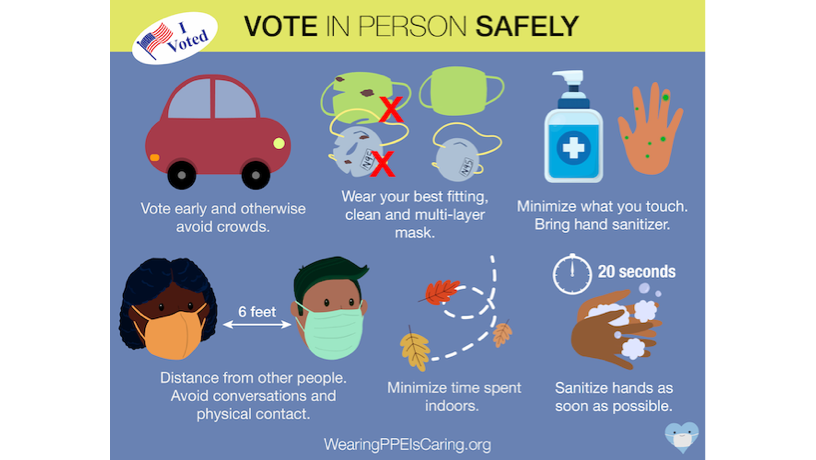Need Tips for Safer In-Person Voting? Here’s Six Suggestions for Reducing Your Risk
Oct 28 2020 | Graphic Credit: Elaine Lee for Wearing Is Caring

Millions of Americans are heading to the polls between now and November 3rd, even as the pandemic’s third wave builds across the U.S. So how can you make sure your vote counts, while minimizing the risk of in-person voting?
Biomedical engineer Elizabeth Hillman has been working closely with frontline healthcare workers since the pandemic began, including designing personal protective equipment (PPE). Hillman, who is also the Herbert and Florence Irving Professor at the Zuckerman Institute, shared six tips for in-person voters based on Wearing is Caring, an information campaign that she and a group of Columbia students and post-docs launched this summer.
- If possible, walk, bike or drive to your polling station rather than taking mass transit. Try to go at a time when you expect the fewest other voters. Forty-three states and the District of Columbia are offering early voting. Take advantage of your state’s early voting period to help avoid crowds.
- Wear your best mask – that means the one that’s the best fitting, cleanest with the most layers (visit https://www.wearingppeiscaring.org for help selecting your best mask and wearing it right!). For those who are high risk, N95 masks can be a good choice, but remember they are only working if they fit tightly onto your face along all edges. Check your fit by testing whether air comes in the edges when you breath in. A mask that does not leak when you breath out will be most protective to others (masks with valves, neck gaiters, bandanas, and those that are single layer or made of fleece offer poor protection).
- Bring hand sanitizer, or wear disposable gloves. While you are inside, take care to minimize what you touch, and do not touch your own possessions (purse, phone, wallet, hair, glasses, face) without using hand sanitizer first (or changing gloves).
- When standing in line, ensure a 6 foot distance between yourself and people around you. If they will not move, move yourself. Stay outdoors or in fresh air as long as possible. If you do not see distancing protocols being enforced, report it, and request that others move away from you if needed.
- Avoid conversation while standing in line – speaking can generate a lot of aerosols and you’re likely to be face to face with the person you are speaking to. Distance yourselves from others who are speaking. Avoid all handshakes, high-fives, or hugs.
- Try to avoid extraneous tasks when you are in the building / voting area. Once back outside, sanitize hands or remove and discard gloves before using your phone, eating, drinking, or touching your other possessions.
Stay safe everyone!
